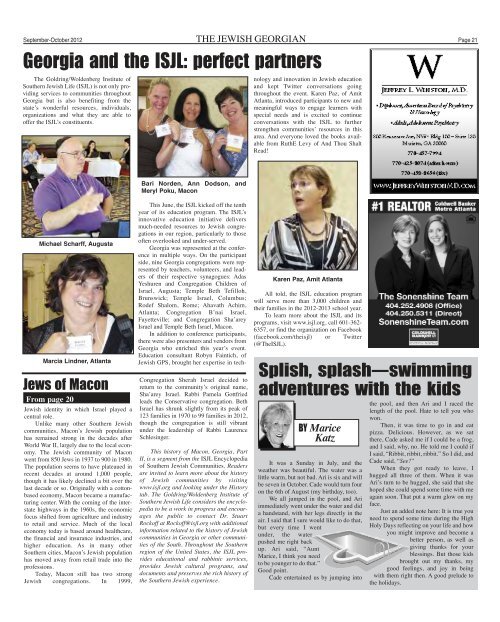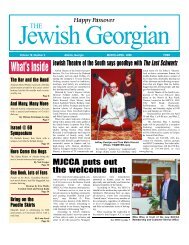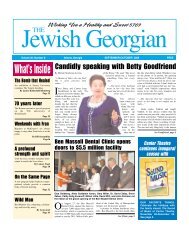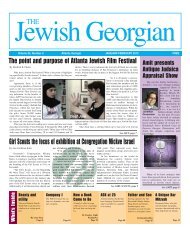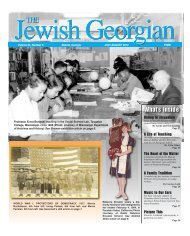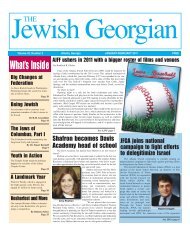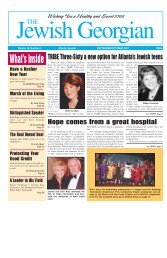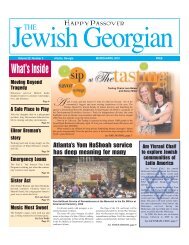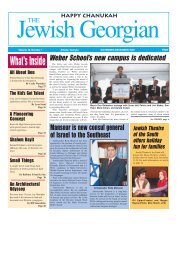mjcca news - The Jewish Georgian
mjcca news - The Jewish Georgian
mjcca news - The Jewish Georgian
Create successful ePaper yourself
Turn your PDF publications into a flip-book with our unique Google optimized e-Paper software.
September-October 2012 THE JEWISH GEORGIAN Page 21<br />
Georgia and the ISJL: perfect partners<br />
<strong>The</strong> Goldring/Woldenberg Institute of<br />
Southern <strong>Jewish</strong> Life (ISJL) is not only providing<br />
services to communities throughout<br />
Georgia but is also benefiting from the<br />
state’s wonderful resources, individuals,<br />
organizations and what they are able to<br />
offer the ISJL’s constituents.<br />
Michael Scharff, Augusta<br />
Marcia Lindner, Atlanta<br />
Jews of Macon<br />
From page 20<br />
<strong>Jewish</strong> identity in which Israel played a<br />
central role.<br />
Unlike many other Southern <strong>Jewish</strong><br />
communities, Macon’s <strong>Jewish</strong> population<br />
has remained strong in the decades after<br />
World War II, largely due to the local economy.<br />
<strong>The</strong> <strong>Jewish</strong> community of Macon<br />
went from 850 Jews in 1937 to 900 in 1980.<br />
<strong>The</strong> population seems to have plateaued in<br />
recent decades at around 1,000 people,<br />
though it has likely declined a bit over the<br />
last decade or so. Originally with a cottonbased<br />
economy, Macon became a manufacturing<br />
center. With the coming of the interstate<br />
highways in the 1960s, the economic<br />
focus shifted from agriculture and industry<br />
to retail and service. Much of the local<br />
economy today is based around healthcare,<br />
the financial and insurance industries, and<br />
higher education. As in many other<br />
Southern cities, Macon’s <strong>Jewish</strong> population<br />
has moved away from retail trade into the<br />
professions.<br />
Today, Macon still has two strong<br />
<strong>Jewish</strong> congregations. In 1999,<br />
Bari Norden, Ann Dodson, and<br />
Meryl Poku, Macon<br />
This June, the ISJL kicked off the tenth<br />
year of its education program. <strong>The</strong> ISJL’s<br />
innovative education initiative delivers<br />
much-needed resources to <strong>Jewish</strong> congregations<br />
in our region, particularly to those<br />
often overlooked and under-served.<br />
Georgia was represented at the conference<br />
in multiple ways. On the participant<br />
side, nine Georgia congregations were represented<br />
by teachers, volunteers, and leaders<br />
of their respective synagogues: Adas<br />
Yeshuren and Congregation Children of<br />
Israel, Augusta; Temple Beth Tefilloh,<br />
Brunswick; Temple Israel, Columbus;<br />
Rodef Shalom, Rome; Ahavath Achim,<br />
Atlanta; Congregation B’nai Israel,<br />
Fayetteville; and Congregation Sha’arey<br />
Israel and Temple Beth Israel, Macon.<br />
In addition to conference participants,<br />
there were also presenters and vendors from<br />
Georgia who enriched this year’s event.<br />
Education consultant Robyn Faintich, of<br />
<strong>Jewish</strong> GPS, brought her expertise in tech-<br />
Congregation Sherah Israel decided to<br />
return to the community’s original name,<br />
Sha’arey Israel. Rabbi Pamela Gottfried<br />
leads the Conservative congregation. Beth<br />
Israel has shrunk slightly from its peak of<br />
123 families in 1970 to 99 families in 2012,<br />
though the congregation is still vibrant<br />
under the leadership of Rabbi Laurence<br />
Schlesinger.<br />
This history of Macon, Georgia, Part<br />
II, is a segment from the ISJL Encyclopedia<br />
of Southern <strong>Jewish</strong> Communities. Readers<br />
are invited to learn more about the history<br />
of <strong>Jewish</strong> communities by visiting<br />
www.isjl.org and looking under the History<br />
tab. <strong>The</strong> Goldring/Woldenberg Institute of<br />
Southern <strong>Jewish</strong> Life considers the encyclopedia<br />
to be a work in progress and encourages<br />
the public to contact Dr. Stuart<br />
Rockoff at Rockoff@isjl.org with additional<br />
information related to the history of <strong>Jewish</strong><br />
communities in Georgia or other communities<br />
of the South. Throughout the Southern<br />
region of the United States, the ISJL provides<br />
educational and rabbinic services,<br />
provides <strong>Jewish</strong> cultural programs, and<br />
documents and preserves the rich history of<br />
the Southern <strong>Jewish</strong> experience.<br />
nology and innovation in <strong>Jewish</strong> education<br />
and kept Twitter conversations going<br />
throughout the event. Karen Paz, of Amit<br />
Atlanta, introduced participants to new and<br />
meaningful ways to engage learners with<br />
special needs and is excited to continue<br />
conversations with the ISJL to further<br />
strengthen communities’ resources in this<br />
area. And everyone loved the books available<br />
from RuthE Levy of And Thou Shalt<br />
Read!<br />
Karen Paz, Amit Atlanta<br />
All told, the ISJL education program<br />
will serve more than 3,000 children and<br />
their families in the 2012-2013 school year.<br />
To learn more about the ISJL and its<br />
programs, visit www.isjl.org, call 601-362-<br />
6357, or find the organization on Facebook<br />
(facebook.com/theisjl) or Twitter<br />
(@<strong>The</strong>ISJL).<br />
Splish, splash—swimming<br />
adventures with the kids<br />
BY<br />
Marice<br />
Katz<br />
It was a Sunday in July, and the<br />
weather was beautiful. <strong>The</strong> water was a<br />
little warm, but not bad. Ari is six and will<br />
be seven in October. Cade would turn four<br />
on the 6th of August (my birthday, too).<br />
We all jumped in the pool, and Ari<br />
immediately went under the water and did<br />
a handstand, with her legs directly in the<br />
air. I said that I sure would like to do that,<br />
but every time I went<br />
under, the water<br />
pushed me right back<br />
up. Ari said, “Aunt<br />
Marice, I think you need<br />
to be younger to do that.”<br />
Good point.<br />
Cade entertained us by jumping into<br />
the pool, and then Ari and I raced the<br />
length of the pool. Hate to tell you who<br />
won.<br />
<strong>The</strong>n, it was time to go in and eat<br />
pizza. Delicious. However, as we sat<br />
there, Cade asked me if I could be a frog,<br />
and I said, why, no. He told me I could if<br />
I said, “Ribbit, ribbit, ribbit.” So I did, and<br />
Cade said, “See?”<br />
When they got ready to leave, I<br />
hugged all three of them. When it was<br />
Ari’s turn to be hugged, she said that she<br />
hoped she could spend some time with me<br />
again soon. That put a warm glow on my<br />
face.<br />
Just an added note here: It is true you<br />
need to spend some time during the High<br />
Holy Days reflecting on your life and how<br />
you might improve and become a<br />
better person, as well as<br />
giving thanks for your<br />
blessings. But those kids<br />
brought out my thanks, my<br />
good feelings, and joy in being<br />
with them right then. A good prelude to<br />
the holidays.


